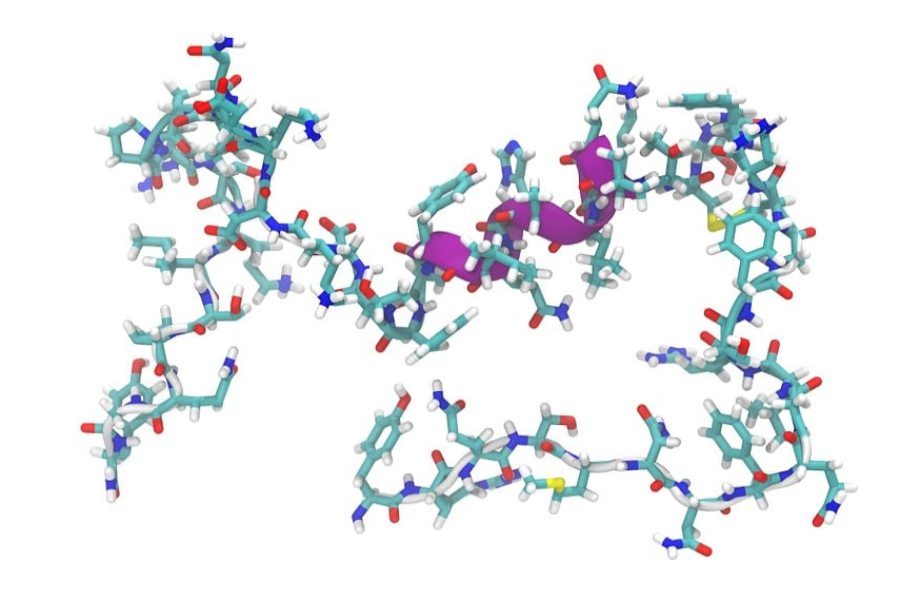Peptides, the “building blocks” of proteins, comprise anything from 2-50 amino acids. However, a peptide lacks the abundance of amino acids seen in proteins. [i], [ii] Synthetic counterparts have been developed with the intention of mimicking the action of native peptides.
Studies suggest that as immunomodulating compounds, peptides and peptidomimetics may inhibit an immunological response or stimulate an immune response to create tolerance. [12]
Peptides and Inflammation
Inflammation is a normal defense reaction to harmful stimuli like wounds or infections. [iii] Pro-inflammatory mediators such cytokines, chemokines, interleukins, and growth factors are produced and secreted as part of the inflammatory response. [iii]
Research suggests that anti-inflammatory capabilities have been suggested by proteins and peptides derived from various sources, including eggs, milk, soy, plants, and marine organisms.
Findings imply that bioactive peptides, which may have anti-inflammatory properties, are the subject of intensive research for their potential utility in mitigating the effects of inflammatory disorders. [iii]
BPC 157 Peptide and Tissue Repair
BPC-157 is a 15-amino-acid pentapeptide. Body protection compound (BPC) is also a partial sequence found and isolated from stomach acid. [9]
Investigations purport that the proposed protective mechanism of BPC-157 and its possible connections with other systems may be due to the pentadecapeptide’s alleged protection against various gastrointestinal and liver diseases and its potential anti-inflammatory and analgesic properties. [11]
Angiogenesis
Angiogenesis is a vital part of the process of repairing damaged tissues; it is a complicated and natural process regulated by angiogenic and angiostatic molecules. [10]
The pentadecapeptide BPC-157 has been suggested to have angiogenic and angiomodulatory properties, suggesting its potential as a healing agent. The vascular endothelial growth factor (VEGF) is a key regulator of blood vessel formation (angiogenesis). [10]
Researchers speculate BPC-157 may stimulate angiogenesis by increasing VEGF expression, and this effect seems to have tight ties to the healing process as seen in research experiments. [10]
Repair
This peptide has been speculated to hasten the recovery of various wounds [9]. BPC-157 suggests promise as a potential first-line agent for non-healing wounds and chronic stomach ulcers. [11]
Muscle, Tendon, and Bone
Studies suggest BPC-157 may speed up the recovery time for repairing damaged connective tissues. BPC-157 research has also implicated the peptide in possible scenarios to relieve symptoms like joint pain, inflammation, strains, sprains, and tendon injuries.
Findings imply that BPC-157 may stimulate FAK-paxillin pathway activation, which may enhance the expansion of tendon fibroblasts from tendon explants, cell survival suffering stress, and in vitro migration of tendon fibroblasts. [9]
Investigations purport that growth and healing of the tendon may be accelerated by its potential to induce the production of receptors that bind to growth signaling molecules in the tendon cells.
Additionally, researchers speculate tendon fibroblasts may benefit from BPC-157’s potential damage restoration properties through upregulating growth hormone receptor expression.
Collagen is an important and abundant structural protein, and scientists hypothesize BPC-157 may enhance the proliferation of fibroblasts, which play a crucial role in collagen production.
TB 500 Peptide and Inflammation
Researchers speculate that synthetic TB-500 may mimic the natural peptide LKKTETQ found in Thymosin 4, the active site responsible for actin binding, cell migration, and wound healing. [vi]
Thymosin 4 is considered to be a regenerative peptide in all tissues and cell types except for red blood cells. It is water-soluble and has a very high degree of conservation. [iv]
Tears, saliva, cerebrospinal fluid, wound fluids, and blood all contain it. Tearing fluids from wounds contains Thymosin 4, released from platelets and leukocytes. There are just 43 amino acids in Thymosin 4; however, it seems to have a wide variety of functions. [iv]
What Role Does TB 500 Play?
Scientists hypothesize that the short peptide may sequester G actin Thymosin 4 [v]. Studies suggest it may boost tumor metastasis, speed wound recovery, and induce angiogenesis.
Research suggests Thymosin 4 may stimulate angiogenesis, wound healing, and hair development through studies observing the impact of peptide exposure in young and old rats. [v] It is now being tested in research studies for wound healing, which is expected to potentially increase angiogenesis and cell migration. [v]
Findings imply that tissues damaged by cutaneous insult, traumatic brain injury, spinal cord damage, stroke, multiple sclerosis, ischemic limbs, and ischemia to the heart may all respond favorably to Thymosin 4. [iv]
A rat dermal investigation first suggested Thymosin 4’s potential to stimulate tissue healing. [iv] It was speculated to be rich in platelets and to stimulate angiogenesis. [iv]
Investigations purport that endothelial cell differentiation, cutaneous angiogenesis, keratinocyte migration, collagen deposition, and inflammation suppression may all potentially benefit from TB 500 influence. [vi]
In addition to suppressing pro-inflammatory chemokines and cytokines, researchers speculate that Thymosin 4 may also promote cell migration, blood vessel development, cell survival, and the maturation of stem cells. The numerous potential wound-healing properties as speculated in animal studies, may be attributed to these actions. [vii]
Core Peptides is the highest-quality, most affordable source of peptides for researchers interested in studying these compounds. Human consumption of any kind is strictly prohibited.





















